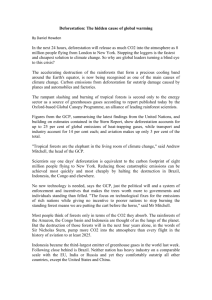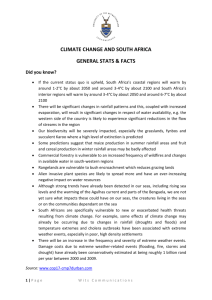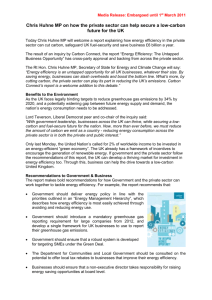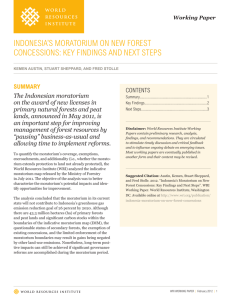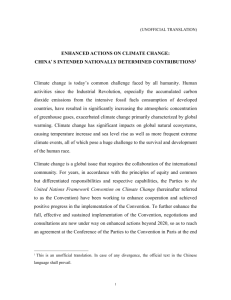Others
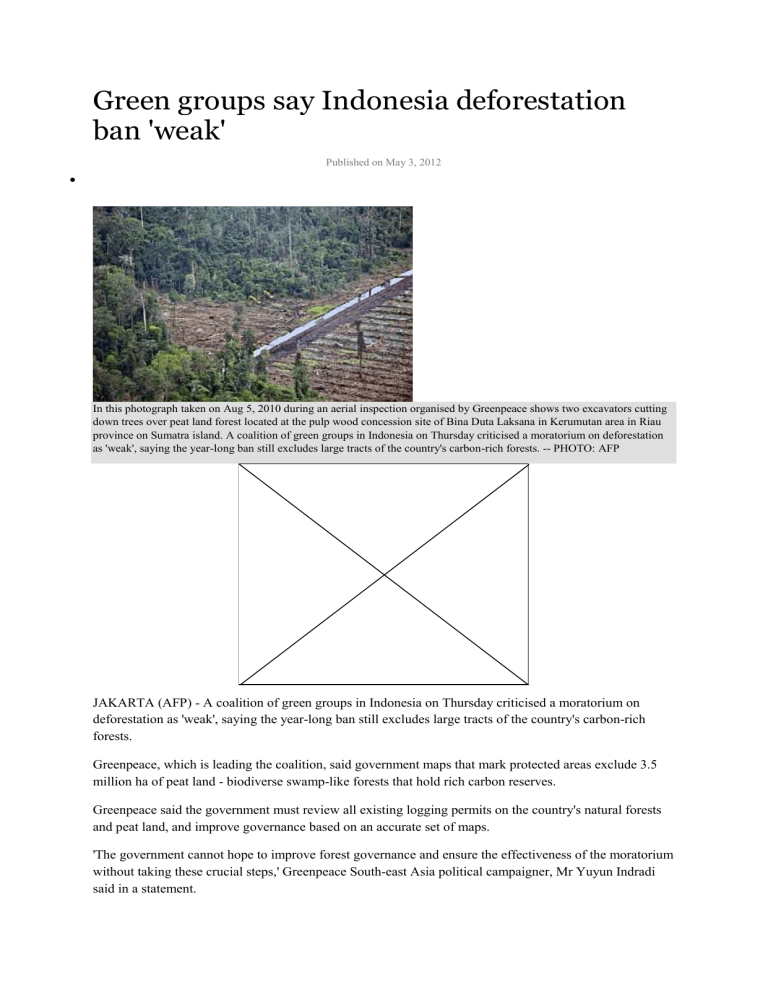
Green groups say Indonesia deforestation ban 'weak'
Published on May 3, 2012
In this photograph taken on Aug 5, 2010 during an aerial inspection organised by Greenpeace shows two excavators cutting down trees over peat land forest located at the pulp wood concession site of Bina Duta Laksana in Kerumutan area in Riau province on Sumatra island. A coalition of green groups in Indonesia on Thursday criticised a moratorium on deforestation as 'weak', saying the year-long ban still excludes large tracts of the country's carbon-rich forests. -- PHOTO: AFP
JAKARTA (AFP) - A coalition of green groups in Indonesia on Thursday criticised a moratorium on deforestation as 'weak', saying the year-long ban still excludes large tracts of the country's carbon-rich forests.
Greenpeace, which is leading the coalition, said government maps that mark protected areas exclude 3.5 million ha of peat land - biodiverse swamp-like forests that hold rich carbon reserves.
Greenpeace said the government must review all existing logging permits on the country's natural forests and peat land, and improve governance based on an accurate set of maps.
'The government cannot hope to improve forest governance and ensure the effectiveness of the moratorium without taking these crucial steps,' Greenpeace South-east Asia political campaigner, Mr Yuyun Indradi said in a statement.
An earlier review of the maps by the Union of Concerned Scientists found that the moratorium leaves almost 50 per cent of Indonesia's 100 million ha of natural forest and peat land unprotected.
'The current moratorium is weak and does very little in effect to protect the forests,' said Mr Deddy Ratih, a forest campaign manager for Friends of the Earth Indonesia.
The two-year moratorium came into effect last year as the centrepiece of a deal with Norway, which pledged US$1 billion (S$1.2 billion) to Indonesia under a United Nations-backed scheme to reduce emissions from deforestation.
That deal was part of a larger commitment made by President Susilo Bambang Yudhoyono in 2009 to reduce greenhouse gas emissions from levels that year by 26 per cent by 2020, or 41 per cent with international support.
The coalition charged that the moratorium - which was originally supposed to include all natural forests - had been watered down to protect just older primary forests and peatland because of pressure from big business.
Indonesia is often cited as the world's third-biggest emitter of greenhouse gases, due mainly to rampant deforestation by the palm oil, mining and paper industries.
China must act urgently to curb emissions:
World Bank
Published on May 3, 2012
The China Central Television (CCTV) tower is hardly visible as fog covers most of Beijing on March 17, 2012. China must act urgently on multiple fronts if it is to cut greenhouse gas emissions from its rapidly expanding cities and hit government targets for curbing carbon intensity, a new report from the World Bank said on Thursday. -- PHOTO: AFP
BEIJING (REUTERS) - China must act urgently on multiple fronts if it is to cut greenhouse gas emissions from its rapidly expanding cities and hit government targets for curbing carbon intensity, a new report from the World Bank said on Thursday.
Cities generate an estimated 70 per cent of energy-related greenhouse gases and with China set to increase its number of urban residents by 350 million over the next 20 years, the Bank says the case for urgent action is strong.
'For the 12th Five-Year Plan period, a 17 percent reduction target for carbon intensity has been set,' World
Bank country director for China, Mr Klaus Rohland, wrote in a foreward to the 588-page report.
'Addressing cities' emissions will be a crucial element of this planned reduction.'
China has set a goal of reducing the economy's carbon intensity by 40-45 per cent in 2020 compared with
2005, while the Five-Year Plan covers the period from 2011-2015.
The report, titled Sustainable Low-Carbon City Development In China, says industry and power generation each contribute as much as 40 per cent of city emissions. The remaining 20 per cent of the carbon footprint is left by transport, buildings and waste.
The Bank called for energy-efficient buildings and industries, transport systems offering alternatives to cars, and better management of water and waste, making five key recommendations to achieve low-carbon city development.
'A few key complementary actions - on the land and municipal finance agenda, on facilitating coordination across different governmental entities - could help to empower city governments to effectively implement low-carbon action plans,' said Mr Shomik Mehindratta, a co-editor of the report, said in the World Bank statement.
The report said it did not set out to be a compendium of best practice, but a collection of material building on analytical work and real investment project experiences.
To that end, the final chapter of the report is given over to an analysis of the financial instruments the
World Bank has available to support the building of low-carbon cities in China.
The Bank said 67 per cent of projects in its existing China lending portfolio had environmental, climate change, or low-carbon objectives.
'In the Chinese context, where the financial architecture to support low-carbon investments is still evolving, the expertise the World Bank has developed and its ability to blend different instruments to finance lowcarbon projects represent a unique opportunity,' the report said.
An update to the report is planned over the next 18 to 24 months to update the findings and lessons presented, as well as experience from the implementation of pilot schemes.
